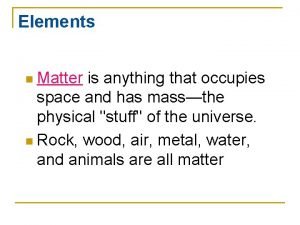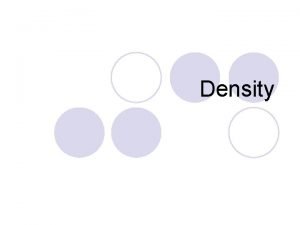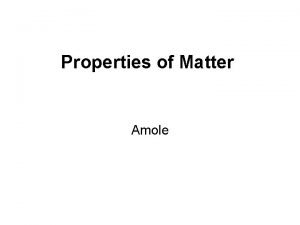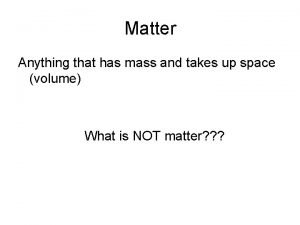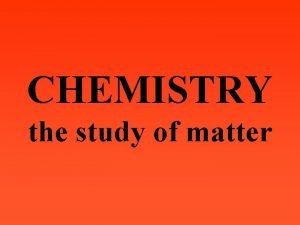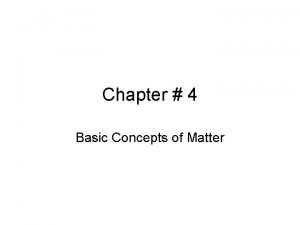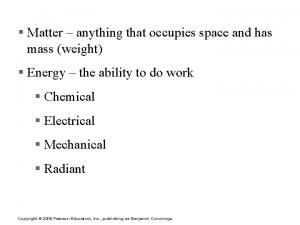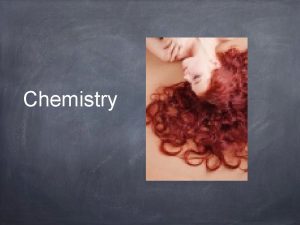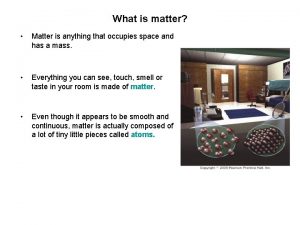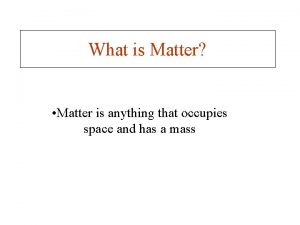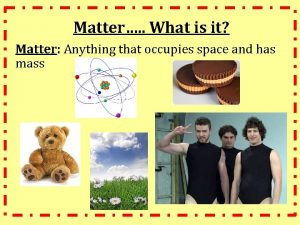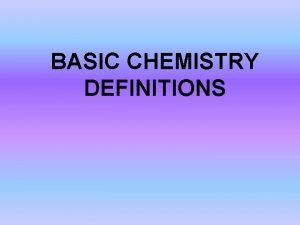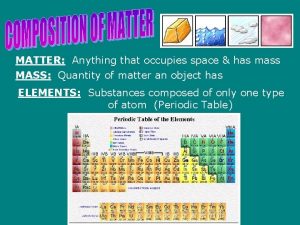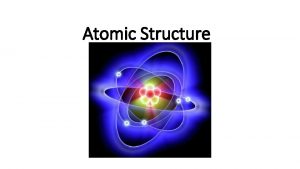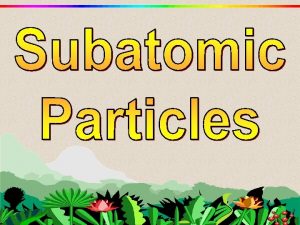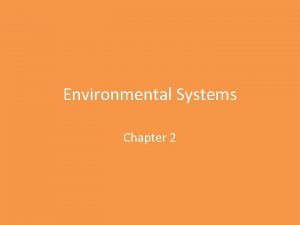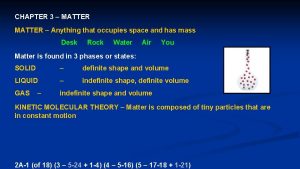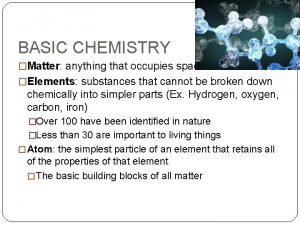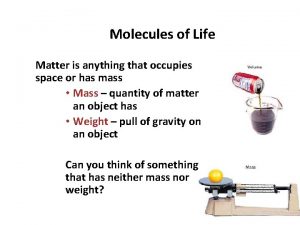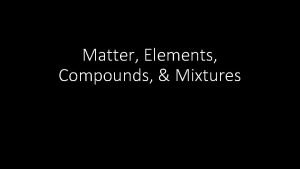What is matter Matter is anything that occupies

























- Slides: 25

What is matter? • Matter is anything that occupies space and has a mass. • Everything you can see, touch, smell or taste in your room is made of matter. • Even though it appears to be smooth and continuous, matter is actually composed of a lot of tiny little pieces called atoms.

Atoms and Molecules • Atoms are the tiny particles that make up all matter. • In most substances, the atoms are joined together in units called molecules and compounds.

Different States of Matter • Matter can be solids, liquids, gases or plasma. • Changing matter from one state to another is called “change in state”. Melting, boiling and freezing are all examples of changes in state. • The atoms, molecules or compounds have different structures in solids, liquids and gases which leads to different properties.


Solids • The particles in a solid are packed close together and are fixed in position – though they may vibrate. • The close packing of the particles results in solids being incompressible. • The inability of the particles to move around results in solids retaining their shape and volume when placed in a new container; and prevents the particles from flowing.

• some solids have their particles arranged in an orderly geometric pattern – we call these crystalline solids salt and diamonds • other solids have particles that do not show a regular geometric pattern over a long range – we call these amorphous solids plastic and glass

Liquids • The particles in a liquid are closely packed, but they have some ability to move around. • The close packing results in liquids being incompressible. • But, the ability of the particles to move allows liquids to take the shape of their container and to flow – however they don’t have enough freedom to escape and expand to fill the container.

Gases • In the gas state, the particles have complete freedom from each other. • The particles are constantly flying around, bumping into each other and the container. • In the gas state, there is a lot of empty space between the particles – on average. • Because there is a lot of empty space, the particles can be squeezed closer together – therefore gases are compressible. • Because the particles are not held in close contact and are moving freely, gases expand to fill and take the shape of their container, and will flow.

States of Matter H 2 O State Gas Liquid Solid ‘Water’ Steam Water Ice Shape Variable Constant Volume Variable Constant Particle Movement Random - each Random, but Fixed - limited particle can go only under motion anywhere the surface Compressib Yes No No ility

Chemical and Physical Properties • Physical properties: characteristics that are measured or observed that identify a substance without changing the chemical composition of the substance Examples: melting, boiling, color, smell, taste, density • Chemical properties: Those properties a substance displays only through changing its composition. Comparison: The characteristic odor of gasoline is a physical property-gasoline does not change its composition when it exhibits odor. On the other hand, the flammability of gasoline is a chemical property-gasoline does change its composition when it burns.

Some Physical Properties Some Chemical Properties

Chemical and Physical Changes • Physical change occurs when the appearance of a substance changes but the chemical composition of the substance remains the same. Melting, freezing and boiling of a substance are a few examples. – The kinds of molecules don’t change. • Chemical changes result in a substance changing into a new substance(s) with different composition(s) and different physical properties. A chemical reaction results in chemical changes. –The new substances have different molecules than the original substances. –You will observe different physical properties because the new substances have their own physical properties.

Phase Changes are Physical Changes • • Boiling = liquid to gas Melting = solid to liquid Subliming = solid to gas Condensing = gas to liquid Freezing = liquid to solid Deposition = gas to solid state changes require heating or cooling the substance

What happened to the snowman? Why is the density of H 2 O(l) > H 2 O(s)?

What is Energy? • Energy is the capacity to do work. • The total amount of Energy is constant and cannot change; i. e. , Energy can be transferred from one substance to another and can be changed from one form to another but not created (Remember the snowman!): – – Kinetic Energy is energy associated with motion. Potential Energy is energy that is stored energy. Electrical Energy is energy caused by the flow of electric charges. Chemical Energy is the result of a chemical reaction associated with the generation of heat.

Law of Conservation of Energy • • • “Energy can neither be created nor destroyed. ” The total amount of energy in the universe is constant – there is no process that can increase or decrease that amount. However, we can transfer energy from one place in the universe to another and we can change its form.

Matter Possesses Energy • • When a piece of matter possesses energy, it can give some or all of it to another object. All chemical and physical changes result in the matter changing energy. Matter Can Lose Energy • • If a process was 100% efficient, we could theoretically get all the energy transformed into a useful form. But, unfortunately, we cannot get a 100% efficient process. The energy “lost” in the process is energy transformed into a form we cannot use. Most of the energy in the combustion of gasoline is transformed into heat energy that escapes into the air

What is Temperature? • Temperature is a measurement of random motion of atoms in matter. - It is a measure of the average kinetic energy of molecules. • The higher the random motion, the higher the temperature. • Units of temperature are Kelvin (K), Celsius (° C) which is also called Centigrade, and Fahrenheit (° F). What is Heat? • Heat is the exchange of thermal energy between samples of matter. • Heat flows from the matter that has high thermal energy to matter that has low thermal energy – until they reach the same temperature. • Heat is exchanged through molecular collisions between two samples.

Change in state of water

Why do liquids boil?

Matter can be pure or a mixture • Pure matter has a definite composition that does not change. • Elements and compounds represent pure substances. • Most matter exists as a mixture that can be separated into pure substances using physical methods: Na. Cl dissolved in water is an example. Matter Pure Substance Mixture Constant Composition Variable Composition Homogeneous or Heterogeneous Homogeneous

Pure Substances vs. Mixtures • 1) Pure Substances all samples have the same physical and chemical properties 2) constant composition = all samples have the same pieces in the same percentages 3) homogeneous 4) separate into components based on chemical properties temperature usually stays constant while melting or boiling • 1) 2) 3) 4) 5) Mixtures different samples may show different properties variable composition = samples made with the same pure substances may have different percentages homogeneous or heterogeneous separate into components based on physical properties temperature changes while melting or boiling because composition changes

Separation of Mixtures • Separate mixtures based on different physical properties of the components – Physical change Different Physical Property Technique Boiling Point Distillation State of Matter (solid/liquid/gas) Filtration Adherence to a Surface Chromatography Volatility Evaporation Density Centrifugation & Decanting

How are elements different from compounds? • Smallest piece of an element is called an atom. • Smallest piece of a compound is called a molecule. • Molecules are made of atoms. • All molecules of a compound are identical and can exist as individual discrete units such as gas molecules or liquid molecules. Solids that are in a fixed composition are not usually referred to as molecules. • Each molecule has the same number and type of atoms.

Classifying Pure Substances as Elements and Compounds • • Substances which can not be broken down into simpler substances by chemical reactions are called elements. Most substances are chemical combinations of elements. These are called compounds. – Compounds can be broken down into elements – Properties of the compound are not related to the properties of the elements that compose it
 Matter is anything that occupies
Matter is anything that occupies Anything that has mass and occupies
Anything that has mass and occupies Matter is anything that...
Matter is anything that... It is anything that has mass and occupies space
It is anything that has mass and occupies space It is anything that has mass and occupies space
It is anything that has mass and occupies space Tôn thất thuyết là ai
Tôn thất thuyết là ai Phân độ lown ngoại tâm thu
Phân độ lown ngoại tâm thu Walmart thất bại ở nhật
Walmart thất bại ở nhật Gây tê cơ vuông thắt lưng
Gây tê cơ vuông thắt lưng Block xoang nhĩ độ 2 type 1
Block xoang nhĩ độ 2 type 1 Tìm vết của đường thẳng
Tìm vết của đường thẳng Sau thất bại ở hồ điển triệt
Sau thất bại ở hồ điển triệt Thể thơ truyền thống
Thể thơ truyền thống Hãy nói thật ít để làm được nhiều
Hãy nói thật ít để làm được nhiều Thơ thất ngôn tứ tuyệt đường luật
Thơ thất ngôn tứ tuyệt đường luật Matter anything that
Matter anything that Is oil more dense than water
Is oil more dense than water Matter is anything that has and takes up
Matter is anything that has and takes up No matter anything
No matter anything Anything defintion
Anything defintion Anything that takes up space and has mass
Anything that takes up space and has mass Matter anything that
Matter anything that Whats anything that has mass and takes up space
Whats anything that has mass and takes up space Matter is defined as anything that
Matter is defined as anything that Matter anything that
Matter anything that Matter is anything that
Matter is anything that
